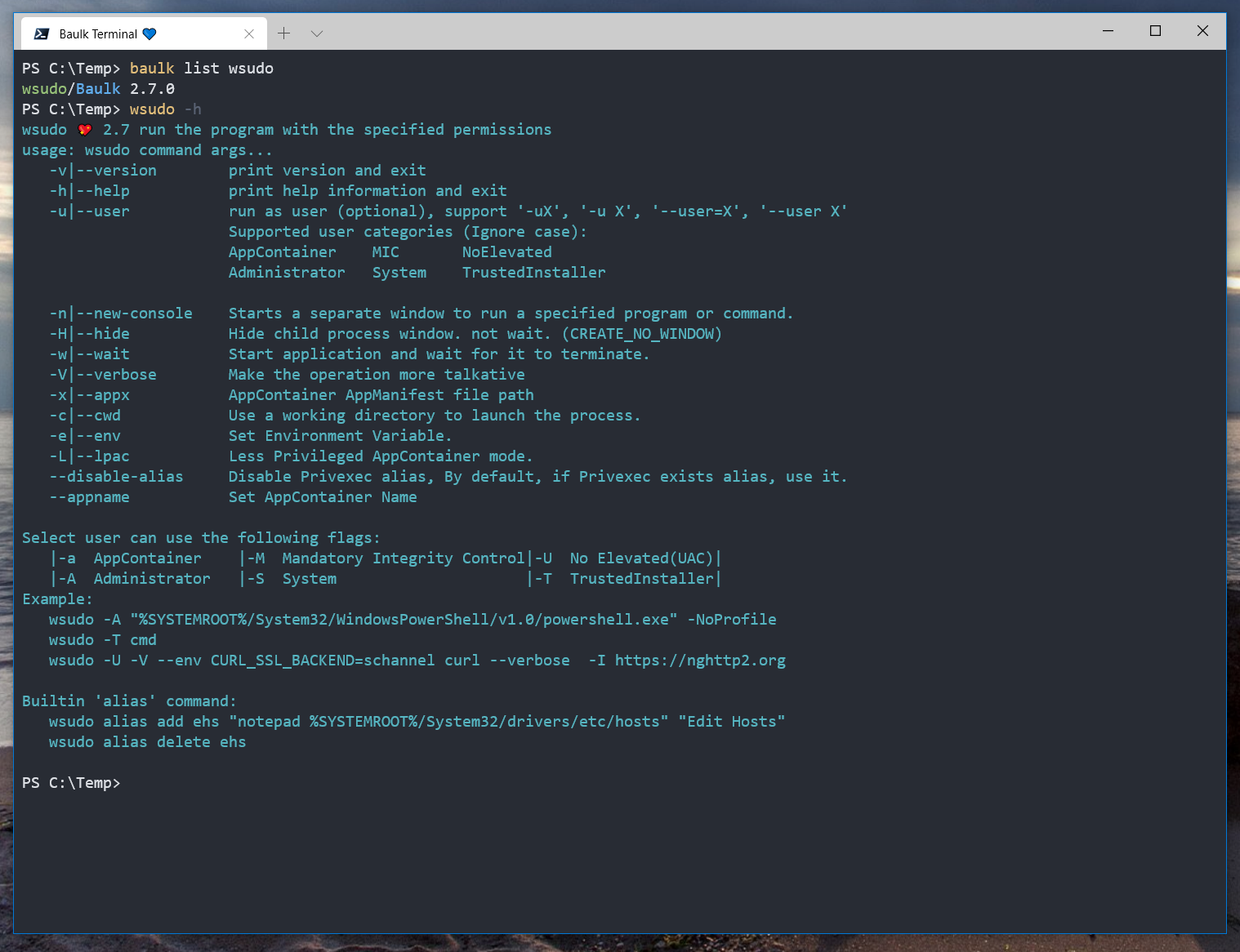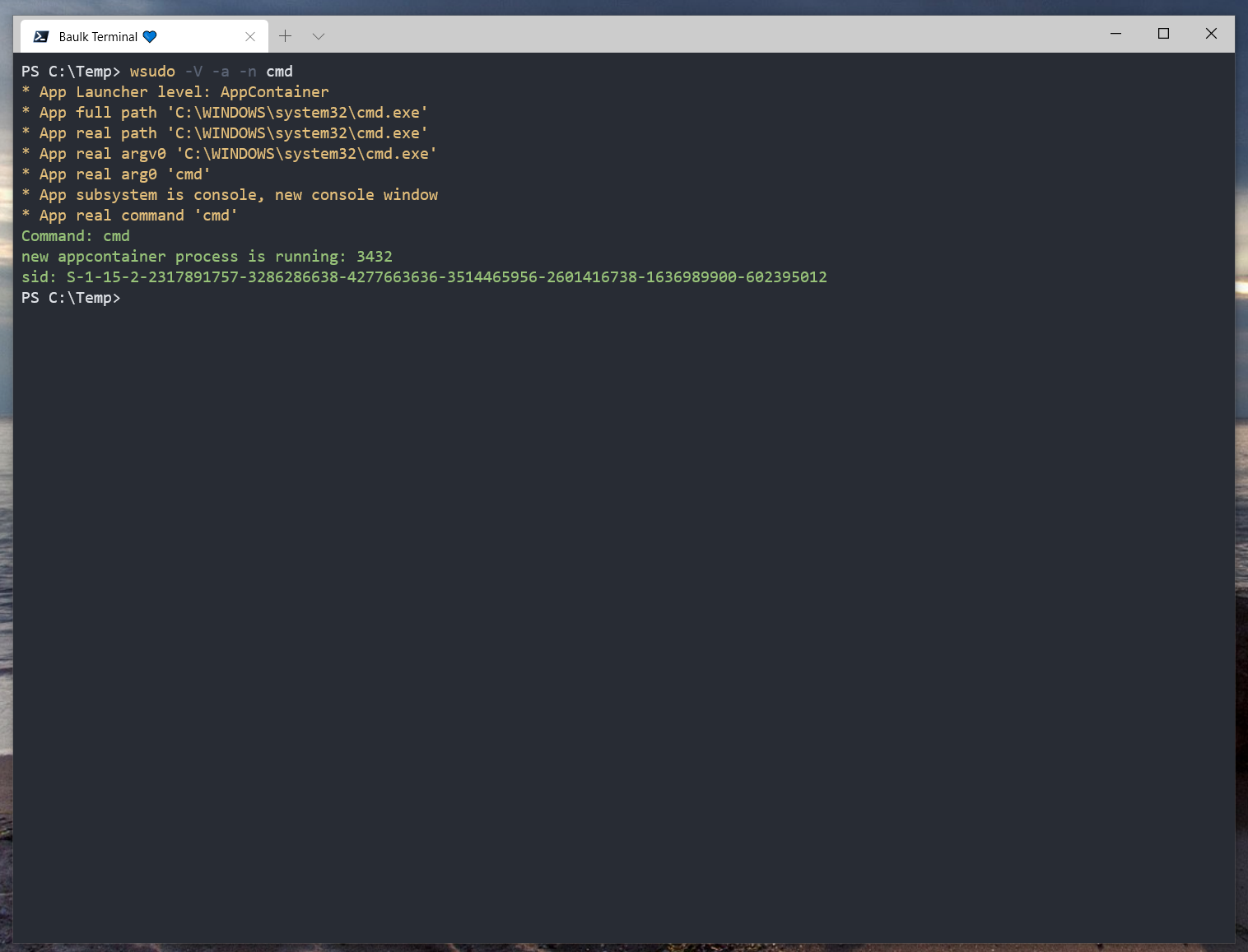前言
Privexec 是笔者借鉴远景好友 MouriNaruto 的 NSudo 而开发的一个提权或者降权执行进程的工具。其中 wsudo 是 Privexec 的命令行版本。
在 wsudo 中,笔者使用了 Privexec.Console 提供彩色输出,截图如下:


本文将讲述标准输出是如何输出到控制台的,以及怎样在 Windows 中实现同时支持标准控制台和 MSYS2 Cygwin 终端模拟器以及 VT 模式的控制台彩色输出。
关于标准输出
大部分编程语言的入门从 Helloworld 开始,也就是将文本 Helloworld 输出到标准输出。在 C++ 中使用 std::cout ,在 C 中使用 printf 以及在 C# 中使用 Console.Write。进程启动时,操作系统或者父进程会设置好进程的标准输出1。默认情况下,标准输出设备是 控制台 console 或者是 终端 tty 当然在启动进程前,可以将标准输出重定向到 管道 (Pipe/Named Pipe, Pipe/FIFO),文件 而在 Unix like 系统中,还可以将输出重定向到 socket 等其他 Unix 文件。在 Windows 上,如果要将 IO 重定向到 socket 需要使用 WSASocket 创建 socket,且不要使用 WSA_FLAG_OVERLAPPED 标志。
输出的设备或者文件存在多样性,对于 CRT 而言,标准输出的实现就要兼顾这些设备,通常来说,操作系统会提供 WriteFile write 这样的 API 或者系统调用支持输出,一般来说,printf 这样的函数也是使用这样的 API 或者系统调用实现。这些函数的输出优先考虑的是本机默认编码,比如 Unix 上,一般都是 UTF-8,对于兼容性大户 Windows 来说,虽然内部编码都是 UTF-16 但是输出到文件时,任然优先选择的是本机代码页,比如在简体中文系统中是,代码页也就是 936。
Printf 的心路历程
在以前我曾经思考过 printf 是如何实现的,很多开发者在开始也有同样的疑惑,在知乎上,就有人提问:printf()等系统库函数是如何实现的? ,在这个问题下,有很多人回复了,有兴趣的用户可以看一下;
在 Unix 的 CRT 中,printf 的调用历程在这篇文章中有详细介绍:Where the printf() Rubber Meets the Road
在 Windows 10 中,新增了 Universal CRT (UCRT) CRT Library Features,Introducing the Universal CRT,与之前的 Visual C++ CRT 有了很大的不同,全部代码使用 C++11 重构,不用疑惑,正是使用 C++11 实现 C Runtime。笔者对 printf 的分析也是基于 ucrt 。
Visual C++ 会将 CRT/C++ STL 源码一同发布(没有构建文件),在 Visual Studio 的安装目录下的 VC\crt\src ,而 UCRT 源码则在 %ProgramFiles(x86)%Windows Kits\10\Source\$BuildVersion\ucrt
在 UCRT 中 printf 是个内联函数,调用了 _vfprintf_l,_vfprintf_l 也是内联 的,它调用了 __stdio_common_vfprintf。在 ucrt 源码路径 stdio\output.cpp 中 __stdio_common_vfprintf 调用了模板函数 common_vfprintf ,而 common_vfprintf 则在内部调用了模板类 output_processor ,output_processor 使用了输出适配器模板类 stream_output_adapter
template <typename Character>
class stream_output_adapter
: public output_adapter_common<Character, stream_output_adapter<Character>>
{
public:
typedef __acrt_stdio_char_traits<Character> char_traits;
stream_output_adapter(FILE* const public_stream) throw()
: _stream{public_stream}
{
}
bool validate() const throw()
{
_VALIDATE_RETURN(_stream.valid(), EINVAL, false);
return char_traits::validate_stream_is_ansi_if_required(_stream.public_stream());
}
bool write_character_without_count_update(Character const c) const throw()
{
if (_stream.is_string_backed() && _stream->_base == nullptr)
{
return true;
}
return char_traits::puttc_nolock(c, _stream.public_stream()) != char_traits::eof;
}
void write_string(
Character const* const string,
int const length,
int* const count_written,
__crt_deferred_errno_cache& status
) const throw()
{
if (_stream.is_string_backed() && _stream->_base == nullptr)
{
*count_written += length;
return;
}
write_string_impl(string, length, count_written, status);
}
private:
__crt_stdio_stream _stream;
};
File stream 的写入流程是 write_strings -> write_string_impl -> write_character -> write_character_without_count_update ,然后是 char_traits::puttc_nolock。
#define _CORECRT_GENERATE_FORWARDER(prefix, callconv, name, callee_name) \
__pragma(warning(push)) \
__pragma(warning(disable: 4100)) /* unreferenced formal parameter */ \
template <typename... Params> \
prefix auto callconv name(Params&&... args) throw() -> decltype(callee_name(args...)) \
{ \
_BEGIN_SECURE_CRT_DEPRECATION_DISABLE \
return callee_name(args...); \
_END_SECURE_CRT_DEPRECATION_DISABLE \
} \
__pragma(warning(pop))
char_traits::puttch_nolock 实际上是通过 __acrt_stdio_char_traits __crt_char_traits 定义的静态成员函数,,printf 对应的是 _fputc_nolock。
_fputc_nolock 和 fputc 类似,实际上 fputc 也会调用它,在 _fputc_nolock 中调用了 __acrt_stdio_flush_and_write_narrow_nolock,在源码 stdio/_flsbuf.cpp 中,
__acrt_stdio_flush_and_write_narrow_nolock 又调用了 common_flush_and_write_nolock<char>
往下一步走会调用 write_buffer_nolock -> _write ->_write_nolock(lowio/write.cpp)
然后根据不同设备和字符类型,_write_nolock 会调用:
- Console ANSI write_double_translated_ansi_nolock
- Console UTF16 write_double_translated_unicode_nolock
- File ANSI write_text_ansi_nolock
- File UTF16 write_text_utf16le_nolock
- File UTF8 write_text_utf8_nolock
- File Binary write_binary_nolock
最后终究要调用 WriteFile,对于不需要缓冲区的文件读写为什么不直接使用 WriteFile ?
值得一提的是,在 Windows 中,如果使用 FILE 读写文件,尽量使用 rb wb 之类的标志,显示的指定文件类型是 binary, 否则自动添加 CR 就不好了。
通过源码,我们还知道 UTF-16 或者 UTF-8 一般还是需要转换成 Ansi 才能输出到控制台。
UCRT 还提供了 _cputs _cprintf _cputws _cwprintf 这样的函数,这些函数处理流程类似但要简单的多,output_processor 的输出适配器是 console_output_adapter,无论是字符类型是 wchar_t 还是 char 最终都会调用 _putwch_nolock 及 __dcrt_write_console_w,最后使用 WriteConsoleW 写入到控制台。
_cwprintf 与 wprintf 相比,输出 Unicode 字符要容易的多,不过,在使用标准输出的时候,你不能假定程序一定拥有控制台。
WriteConsole 内部原理
虽然在 Windows/ReactOS 中,CRT 写入到标准输出的使用了 WriteFile ,WriteFile 是如何写到控制台的?
在 ReactOS 源码中,WriteFile 将检查 hFile 其值是否为 STD_INPUT_HANDLE ,STD_OUTPUT_HANDLE ,STD_ERROR_HANDLE 如果是就从 PEB 中获得对应的控制台句柄,否则使用句柄 hFile 原本的值,然后就判断是否是控制台句柄,如果是控制台,则调用 WriteConsoleA,对于其他类型文件会直接调用 NtWriteFile。
将 STD_*_HANDLE 转换为 Windows 内核对象:
HANDLE
TranslateStdHandle(IN HANDLE hHandle)
{
PRTL_USER_PROCESS_PARAMETERS Ppb = NtCurrentPeb()->ProcessParameters;
switch ((ULONG)hHandle)
{
case STD_INPUT_HANDLE: return Ppb->StandardInput;
case STD_OUTPUT_HANDLE: return Ppb->StandardOutput;
case STD_ERROR_HANDLE: return Ppb->StandardError;
}
return hHandle;
}
判断是否是控制台文件:
#define IsConsoleHandle(h) \
(((ULONG_PTR)(h) & 0x10000003) == 0x3)
或者
BOOL IsConsoleHandle(HANDLE hHandle)
{
DWORD dwMode;
/* Check whether the handle may be that of a console... */
if ((GetFileType(hHandle) & ~FILE_TYPE_REMOTE) != FILE_TYPE_CHAR)
return FALSE;
/*
* It may be. Perform another test... The idea comes from the
* MSDN description of the WriteConsole API:
*
* "WriteConsole fails if it is used with a standard handle
* that is redirected to a file. If an application processes
* multilingual output that can be redirected, determine whether
* the output handle is a console handle (one method is to call
* the GetConsoleMode function and check whether it succeeds).
* If the handle is a console handle, call WriteConsole. If the
* handle is not a console handle, the output is redirected and
* you should call WriteFile to perform the I/O."
*/
return GetConsoleMode(hHandle, &dwMode);
}
有兴趣的可以参阅 ReactOS WriteFile 源码: WriteFile to Console
对于控制台句柄,CloseHandle,ReadFile,CreateFile ,以及 WriteFile 都要单独的调用对象的控制台 API。比如说,如果文件名是 CON, CONOUT$, CONIN$, \\.\CON 时就会使用 OpenConsoleW 打开控制台。然后返回控制台的句柄。
WriteConsoleA 又是如何写入到图形界面呢?在 Windows Technet 有两幅图分别介绍了 Vista 以前的控制台结构和 Windows 7 的控制台架构 Windows 7 / Windows Server 2008 R2: Console Host
在 Windows 7 以前,WriteConsole 通过 LPC 与 CSRSS(Client Server Runtime Process) 通信:

由于CSRSS 以 Local System 权限运行,这样的逻辑容易导致 Shatter attack,于是在 Windows 7 中出现了新的 Console Host :

在这种架构中,WriteConsole LPC 调用将控制台消息发送到了一个 Conhost 宿主进程,这个进程是在 CreateProcess 中自动创建的。
在 ReactOS 中,依然使用的是 CsrCaptureMessageBuffer 将数据发送到 CSRSS。源码在这里: WriteConsole
ReactOS 文档:ReactOS
WriteFile 输出到控制台时,实际调用的是 WriteConsoleA,在前面我们还知道使用 wprintf 时,CRT 会将文本内容转换成 Ansi(Codepage) 然后再使用 WriteFile 写入到控制台窗口。
我们知道,绘制字符的时候,ANSI 文本最终将会转换成 UTF-16LE 文本,然后经 DrawTextExW 或者其他函数绘制出来,如果使用了 wprintf 这样的函数,势必会经过两次转换 UTF16->CodePage->UTF16,在 Unicode 中存在的字符不一定存在于代码页中,这就导致文本在转换编码的时候发生丢失,输出到控制台时,可能是乱码或者干脆截断了。所以在 Windows 控制台中, Unicode 编码,特别是 emoji 还是不要妄想通过 wprintf 输出。
在 Windows 中,内码是 Unicode,而控制台也支持使用 WriteConsoleW 这样的 API 输出文本,如果我们直接使用 WriteConsoleW 就可以避免出现字符无法呈现或者乱码的问题了。如果控制台的图形对各种字体字符支持更好,这个 API 也就能够输出彩色字符或者更多的 Emoji。遗憾的是,目前 Console 字体渲染的改进任然在计划中,暂时不支持 Emoji 和各种特殊字体。
控制台彩色输出
讲了这么长一段,该讲如何实现彩色输出了,首先,我们要知道 Windows 控制台 API 是支持颜色输出的,不过,这些 API 仅支持 16 色输出。 在 .Net Core corefx 有如下一个枚举定义了控制台基本的颜色:
[Serializable]
public enum ConsoleColor
{
Black = 0,
DarkBlue = 1,
DarkGreen = 2,
DarkCyan = 3,
DarkRed = 4,
DarkMagenta = 5,
DarkYellow = 6,
Gray = 7,
DarkGray = 8,
Blue = 9,
Green = 10,
Cyan = 11,
Red = 12,
Magenta = 13,
Yellow = 14,
White = 15
}
在 C++ 中,如果在 WriteConsoleW 调用之前使用了 SetConsoleTextAttribute 设置输出格式,那么就能输出带有上述颜色的文本内容了。在 Privexec.Console 中,使用控制台 API 输出颜色代码如下:
int WriteConhost(int color, const wchar_t *data, size_t len) {
CONSOLE_SCREEN_BUFFER_INFO csbi;
auto hConsole = GetStdHandle(STD_OUTPUT_HANDLE);
GetConsoleScreenBufferInfo(hConsole, &csbi);
WORD oldColor = csbi.wAttributes;
WORD color_ = static_cast<WORD>(color);
WORD newColor;
if (color > console::fc::White) {
newColor = (oldColor & 0x0F) | color_;
} else {
newColor = (oldColor & 0xF0) | color_;
}
SetConsoleTextAttribute(hConsole, newColor);
DWORD dwWrite;
WriteConsoleW(hConsole, data, (DWORD)len, &dwWrite, nullptr);
SetConsoleTextAttribute(hConsole, oldColor);
return static_cast<int>(dwWrite);
}
在这里,我们选择的是 STD_OUTPUT_HANDLE,使用 &0x0F 或者 &0xF0 的目的是不修改原有的背景色或者前景色,第二次调用 SetConsoleTextAttribute 的目的是恢复控制台原有的颜色。
终端模拟器彩色输出
在 Windows 上,还有 Cygwin 和 MSYS2 MSYS 这样的模拟 Unix 的环境。wsudo 对其支持也非常有必要。 这些环境启动进程往往是通过管道通信,这个时候,我们可以判断是否是终端还是控制台。
bool IsWindowsConhost(HANDLE hConsole, bool &isvt) {
if (GetFileType(hConsole) != FILE_TYPE_CHAR) {
return false;
}
DWORD mode;
if (!GetConsoleMode(hConsole, &mode)) {
return false;
}
if ((mode & ENABLE_VIRTUAL_TERMINAL_PROCESSING) != 0) {
isvt = true;
}
return true;
}
如果使用 GetFileType(hConsole) 得到的文件类型不是 FILE_TYPE_CHAR 我们就可以确定不是控制台,并且如果不支持 GetConsoleMode 函数,也要视其不是控制台。
核心代码如下:
namespace console {
std::string wchar2utf8(const wchar_t *buf, size_t len) {
std::string str;
auto N = WideCharToMultiByte(CP_UTF8, 0, buf, (int)len, nullptr, 0, nullptr,
nullptr);
str.resize(N);
WideCharToMultiByte(CP_UTF8, 0, buf, (int)len, &str[0], N, nullptr, nullptr);
return str;
}
struct TerminalsColorTable {
int index;
bool blod;
};
namespace vt {
namespace fg {
enum Color {
Black = 30,
Red = 31,
Green = 32,
Yellow = 33,
Blue = 34,
Magenta = 35,
Cyan = 36,
Gray = 37,
Reset = 39
};
}
namespace bg {
enum Color {
Black = 40,
Red = 41,
Green = 42,
Yellow = 43,
Blue = 44,
Magenta = 45,
Cyan = 46,
Gray = 47,
Reset = 49
};
}
}
bool TerminalsConvertColor(int color, TerminalsColorTable &co) {
std::unordered_map<int, TerminalsColorTable> tables = {
{console::fc::Black, {vt::fg::Black, false}},
{console::fc::DarkBlue, {vt::fg::Blue, false}},
{console::fc::DarkGreen, {vt::fg::Green, false}},
{console::fc::DarkCyan, {vt::fg::Cyan, false}},
{console::fc::DarkRed, {vt::fg::Red, false}},
{console::fc::DarkMagenta, {vt::fg::Magenta, false}},
{console::fc::DarkYellow, {vt::fg::Yellow, false}},
{console::fc::DarkGray, {vt::fg::Gray, false}},
{console::fc::Blue, {vt::fg::Blue, true}},
{console::fc::Green, {vt::fg::Green, true}},
{console::fc::Cyan, {vt::fg::Cyan, true}},
{console::fc::Red, {vt::fg::Red, true}},
{console::fc::Magenta, {vt::fg::Magenta, true}},
{console::fc::Yellow, {vt::fg::Yellow, true}},
{console::fc::White, {vt::fg::Gray, true}},
{console::bc::Black, {vt::bg::Black, false}},
{console::bc::Blue, {vt::bg::Blue, false}},
{console::bc::Green, {vt::bg::Green, false}},
{console::bc::Cyan, {vt::bg::Cyan, false}},
{console::bc::Red, {vt::bg::Red, false}},
{console::bc::Magenta, {vt::bg::Magenta, false}},
{console::bc::Yellow, {vt::bg::Yellow, false}},
{console::bc::DarkGray, {vt::bg::Gray, false}},
{console::bc::LightBlue, {vt::bg::Blue, true}},
{console::bc::LightGreen, {vt::bg::Green, true}},
{console::bc::LightCyan, {vt::bg::Cyan, true}},
{console::bc::LightRed, {vt::fg::Red, true}},
{console::bc::LightMagenta, {vt::bg::Magenta, true}},
{console::bc::LightYellow, {vt::bg::Yellow, true}},
{console::bc::LightWhite, {vt::bg::Gray, true}},
};
auto iter = tables.find(color);
if (iter == tables.end()) {
return false;
}
co = iter->second;
return true;
}
int WriteTerminals(int color, const wchar_t *data, size_t len) {
TerminalsColorTable co;
auto str = wchar2utf8(data, len);
if (!TerminalsConvertColor(color, co)) {
return static_cast<int>(fwrite(str.data(), 1, str.size(), stdout));
}
if (co.blod) {
fprintf(stdout, "\33[1;%dm", co.index);
} else {
fprintf(stdout, "\33[%dm", co.index);
}
auto l = fwrite(str.data(), 1, str.size(), stdout);
fwrite("\33[0m", 1, sizeof("\33[0m") - 1, stdout);
return static_cast<int>(l);
}
这些终端环境基本上将文本视为 UTF8 编码,为了让文字正常显示,我们需要将其转换为 UTF8。经过测试,中文都能正常显示。
VT 模式颜色输出
在 Windows 10 中,新增了 Windows Subsystem for Linux ,可以通过 Bash 命令启动终端运行 Linux 程序,Windows 控制台还增加了 VT 模式 Console Virtual Terminal Sequences,并且支持24-Bit 颜色:24-bit Color in the Windows Console!,这意味着,可以像 Linux 一样在 printf 中添加转义字符控制颜色输出。 在 Github 中也有 Issues 讨论: support 256 color 笔者在开发时发现 WriteConsoleW 也支持 VT 模式,对于也添加了代码支持 VT 模式:
int WriteConsoleInternal(const wchar_t *buffer, size_t len) {
DWORD dwWrite = 0;
auto hConsole = GetStdHandle(STD_OUTPUT_HANDLE);
if (WriteConsoleW(hConsole, buffer, (DWORD)len, &dwWrite, nullptr)) {
return static_cast<int>(dwWrite);
}
return 0;
}
int WriteVTConsole(int color, const wchar_t *data, size_t len) {
TerminalsColorTable co;
if (!TerminalsConvertColor(color, co)) {
return WriteConsoleInternal(data, len);
}
std::wstring buf(L"\x1b[");
if (co.blod) {
buf.append(L"1;").append(std::to_wstring(co.index)).push_back(L'm');
} else {
buf.append(std::to_wstring(co.index)).push_back(L'm');
}
WriteConsoleInternal(buf.data(), (DWORD)buf.size());
auto N = WriteConsoleInternal(data, (DWORD)len);
WriteConsoleInternal(L"\x1b[0m", (sizeof("\x1b[0m") - 1));
return static_cast<int>(N);
}
template <typename... Args>
int PrintConsole(const wchar_t *format, Args... args) {
std::wstring buffer;
size_t size = StringPrint(nullptr, 0, format, args...);
buffer.resize(size);
size = StringPrint(&buffer[0], buffer.size() + 1, format, args...);
return WriteConsoleInternal(buffer.data(), size);
}
由于 VT 模式支持 256 色,这里还增加了 PrintConsole 模板函数,支持用户自定义输出多一些色彩。
输出函数自动选择
在不考虑 freopen 这样的重新设置标准输出输出的情况下,Privexec.Console 使用如下代码支持自动选择不同的输出函数
class ConsoleInternal {
public:
ConsoleInternal() {
HANDLE hConsole = GetStdHandle(STD_OUTPUT_HANDLE);
if (hConsole == INVALID_HANDLE_VALUE) {
impl = WriteFiles;
return;
}
if (GetFileType(hConsole) == FILE_TYPE_DISK) {
impl = WriteFiles;
return;
}
bool isvt = false;
if (IsWindowsConhost(hConsole, isvt)) {
if (isvt) {
impl = WriteVTConsole;
return;
}
impl = WriteConhost;
return;
}
impl = WriteTerminals;
}
int WriteRealize(int color, const wchar_t *data, size_t len) {
return this->impl(color, data, len);
}
private:
int (*impl)(int color, const wchar_t *data, size_t len);
};
int WriteInternal(int color, const wchar_t *buf, size_t len) {
static ConsoleInternal provider;
return provider.WriteRealize(color, buf, len);
}
使用 console::Print 不用担心乱码和颜色问题,在这几个主流的环境中都能正常显示(包括 ConEmu)。Print 使用的完全是 wchar_t。
其他
很欣慰的是 Windows 控制台团队在 Windows 10 开发之处就在不断改进控制台: 比如 Console Improvements in the Windows 10 Technical Preview
还有计划中的 Emoji 支持: Add emoji support to Windows Console
以及基于 DirectWrite 改进控制台字体渲染的计划: UTF-8 rendering woes
当然 ConEmu 也有计划使用 DirectWrite 改进其渲染。
不过遗憾的是,Mintty 的开发者并不认为有使用 DirectWrite 改进渲染的必要。
基于 Rust 的跨平台 GPU 终端 Alacritty - A cross-platform, GPU-accelerated terminal emulator 也计划在 1.0 时对 Windows 提供支持,字体渲染也有 DirectWrite 的身影。
Privexec.Console 官方并不会支持 Windows 10 以前的版本,毕竟作者精力有限。
备注
- 父进程未显式设置标准输入输出和标准错误时,子进程会继承父进程的值,在 Windows 中,GUI 程序的标准输入输出和 Unix 下重定向到
/dev/null类似,但启动的 CUI 子进程默认下依然有控制台窗口
Last modified on 2017-06-05